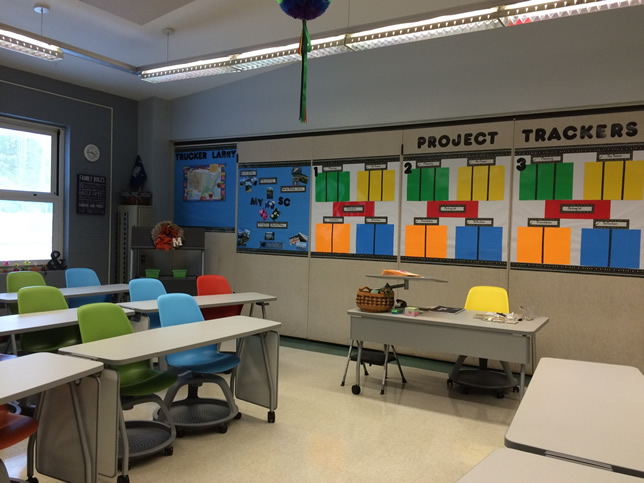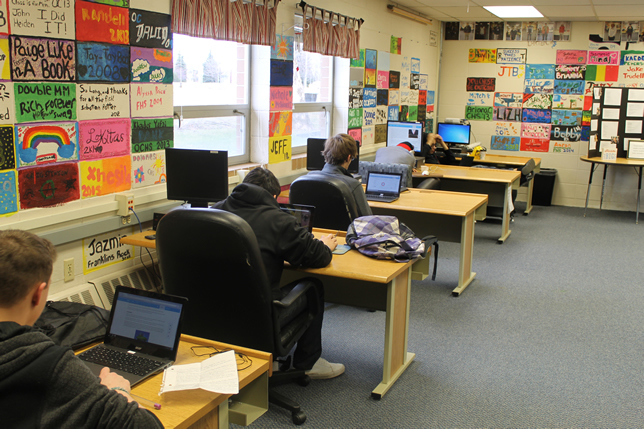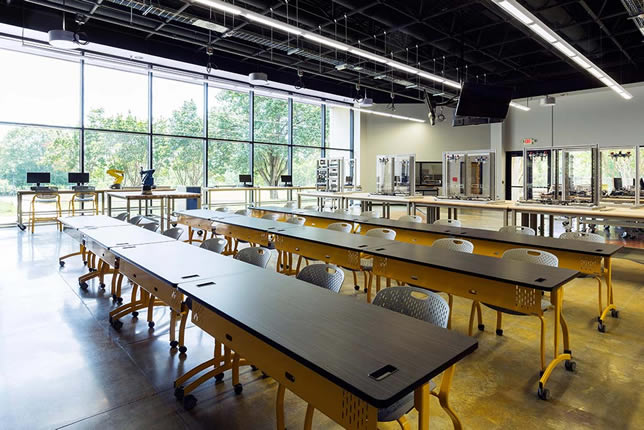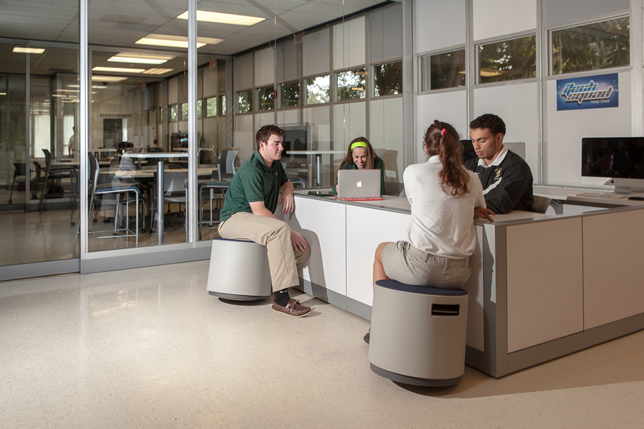4 Ways Furnishings Can Enhance the 21st Century Classroom
Furniture can make or break an educational space. Whether it’s wheels for mobility, plugs for devices or cushions for comfort, furnishings help create the environment best suited to an individual classroom’s needs. Here four educators discuss the furnishings they use to help motivate and engage their students.
Traditional student desks and chairs are a relic of the 19th and 20th centuries. The 21st century classroom, with its 1-to-1 ratio of devices to students and emphasis on collaboration and communication, demands classroom furniture that is mobile and device-friendly. Some schools have replaced their traditional classroom furniture with tables and chairs on wheels to facilitate flexibility and quick transitions between individual, small group and large group activities. Others have implemented soft seating such as sofas and easy chairs with computing surfaces built into the armrests to improve student comfort. And some are using furniture to create a professional, business-like environment as they prepare students for college and career.
Active Learning Center at Saluda Trail Middle School
Saluda Trail Middle School in Rock Hill, SC was a recipient of one of Steelcase Education's 2015 Active Learning Center grants. The company transformed Julie Marshall's language arts classroom to an active learning center complete with tables and chairs on wheels, an interactive whiteboard, student whiteboards and other upgrades. It was "designed to meet the needs of the 21st century learner, emphasizing critical thinking, communication, collaboration and creativity," said Marshall. "By having things on wheels, by having all of the furniture on wheels, it allows for a very mobile, very fluid environment."

Saluda Trail Middle School emphasizes mobility in the classroom, with Steelcase chairs and desks that are easily reconfigured to allow for regular small-group breakouts.
Marshall uses project-based learning for all of her English language arts classes, with mandatory and student-selected projects. At the beginning of each class, Marshall and her students roll their chairs into a large group for a brief mini-lesson. Once the mini-lesson is over, Marshall says, "Ready to rock?" and her students say, "Ready to roll!" and then they roll out into their small groups, either in the classroom or the hallway. "Within two to three minutes they are exactly where they need to be, with who they need to be with, and working," said Marshall. "You can't break a regular traditional classroom down that fast."
Since implementing the active learning center, Marshall has noticed a significant improvement in her students who struggle in school. "The new environment has changed their motivation because they now have control and ownership of what they are doing in class," said Marshall. "Number 1, they control where they sit. Number 2, they control who they sit by or who they work with on a daily basis. Number 3, they can control what they are studying."
According to Marshall, the students are very grateful for the new classroom environment and treat it with a sense of pride. "The gratitude for that classroom is transferring to their work," she said. "The missing work has decreased." The students also go out of their way to keep the new furniture clean, wiping down the desks, sweeping the floor so dirt doesn't get into the wheels of the furniture. "I had to develop a schedule for them to clean because everybody wanted to clean the dry erase boards; everybody wanted to clean the desks. They dust. It's precious. They want everything just perfect."
Marshall said she thinks the new furnishings have also helped her low-achieving students because the environment is non-threatening and because students feel more motivated to take risks emotionally and academically. "A lot of low-achieving students are afraid to try something new in a classroom because all they've done all their life is get in trouble when they try to do something different," she said. "We can't fix things unless we fix motivation, and that's what everybody is struggling with: how to get kids motivated. If you make that room exciting, inviting and non-traditional, it's a place where they can just relax."
Connects Learning Center
Some at-risk students from four area high schools in Cudahy, WI have the option of attending Connects Learning Center, a unique high school designed specifically to help these students succeed through a combination of an individualized blended learning curriculum and a comfortable environment. "These kids have proved that they do not learn or have not been successful in the traditional environment," said Stacey Adamczyk, lead teacher at the school. "So really it's about making an area that's comfortable for them, an area that they want to come to."

Connects Learning Center uses everything from comfy chairs to couches to spacious, tech-friendly workstations with high-backed chairs.
The school is located in a renovated church with three rooms. When you enter the school, the center room serves as a break room, and there's a single classroom on either side, each of which can accommodate about 18 students. The school has a variety of hand-me-down couches, loveseats and recliners for students, a few high-top, bistro-style tables and a few traditional desks with big, comfy chairs. Over the last two to three years, the school has been purchasing OFM Interplay couches and chairs through School Specialty. The Interplay furniture has swivel desks built into the armrest. "We were thinking about creating an environment where kids wanted to be, so we were thinking about where are they going to be most comfortable, what's going to make them want to come to school," said Adamczyk. "And the kids feel as though it's a privilege to be here in this type of environment. They know not all students get that opportunity."
Adamczyk and her students start each day with the couches and chairs arranged in a big circle, and then students roll the furniture to other part of the room to start their school work. Most of the time students work independently using blended learning curriculum from Odysseyware, and then Adamczyk will get small groups of two to six students together for small group lessons. "It's really nice for them to be able to work independently at their own pace and receive the 1-on-1 attention as they need it rather than being expected to learn everything at the same rate at the same time and be at the same level," said Adamczyk. When they're doing their independent work, some of the kids roll a chair to a corner by themselves, while others form little groups, whatever makes them feel comfortable.
Attendance rates at the school range from 80 percent to 100 percent, which is impressive for a group of kids who have been non-attenders in the past, according to Adamczyk. She attributes that change in the students' attitude towards school to the individualized, flexible, comfortable learning environment.
THINC College & Career Academy
THINC College & Career Academy is a public charter school in LaGrange, GA that is focused on career readiness and uses a curriculum designed to meet the needs of local employers. Its students attend one of three regular high schools for half of the day and then for the other half of the day attend THINC, where they take classes in disciplines such as engineering or business administration.

Bretford Explore tables and Motiv seating at THINC College and Career Academy: "We did not want the students to walk in here and feel like they were in a traditional high school setting," said Chris Williams, principal at THINC. "We wanted them to feel that they were experiencing higher ed, business and industry. So we knew that we needed a very collaborative environment."
In preparation for the school's opening in August 2015, the school's designers contacted a local office supply company in search of tables and chairs that could be rearranged easily to support student collaboration. Loy's Office Supply recommended the EDU 2.0 line for furniture from Bretford, including community docking stations and tables with video monitors.
"Our purpose in choosing the furniture was to help create a collaborative environment, and we wanted to promote communication between the students," said Chris Williams, principal of THINC. "We did not want the students to walk in here and feel like they were in a traditional high school setting. We wanted them to feel that they were experiencing higher ed, business and industry. So we knew that we needed a very collaborative environment."
The school purchased a variety of learning tables from Bretford's Explore line and soft seating from the Motiv line. The Motiv seats are wired and include power and USB outlets so students can charge their devices while they work. "We're a very device friendly environment," said Williams. "We're not the typical high school that discourages the use of your personal devices. What we are about is teaching the student how to use those devices appropriately."
THINC College & Career Academy strives to establish a culture of business and industry, of being grown up and professional, and Williams said the furnishings contribute to that culture. "It's hard to play the role of an employee or an adult when you're sitting in a student desk," he said.
Interactive Student Learning Center at Immaculata - La Salle High School
Immaculata - La Salle High School in Miami has converted half of its classrooms to active learning spaces and plans to transform the other half by the 2018–2019 school year. It has also transformed its library into an Interactive Student Learning Center with four active learning spaces, a presentation area and two mediascape rooms.

Immaculata - La Salle High School in Miami has converted half of its classrooms to active learning spaces and has also transformed its library into an Interactive Student Learning Center with four active learning spaces, a presentation area and two mediascape rooms.
The transformation was driven in part by the school's 1-to-1 iPad initiative. "After six months it became very apparent that having the students sit in rows and engage in the device was not working," said Federico Padovan, dean of innovation and technology at the school. "It was creating a very isolated experience, and it went against everything 21st century learning is about."
At the same time, the school needed to expand its classroom space, but it's located next to a historical landmark, so the school had to repurpose existing space rather than build an addition. The staff pared its collection of library books down to essentials that were not available electronically, and was able to reduce its number of library stacks from 32 to one. A group of teachers then spent eight months deciding how to expand classroom space within the library in a way that multiple groups could use it simultaneously without impeding each other. "The goal was to create a truly flexible space that within five minutes could become something else," said Padovan. The result was the Interactive Student Learning Center.
The center's four active learning spaces have Steelcase tables and chairs on wheels. Each space has its own drop-down projector screen and can accommodate groups of 18 to 20 students, with four students per table. When classes need a large, open space, the tables can fold and nest and the chairs can stack. The center also has a presentation area with comfortable furniture and two flat screen televisions. The five spaces can be used independently or combined to accommodate large groups. The two mediascape rooms are enclosed in glass, so they have a sound barrier. One mediascape room can accommodate 14 students, and the other one can accommodate 21. The result has been a truly flexible learning space that is conducive to the communication and collaboration tenets of 21st century learning.